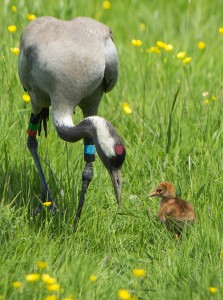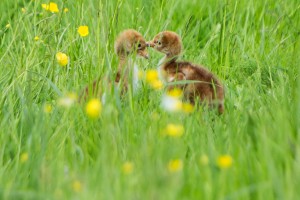Crane chicks mark start of first wild generation for western Britain

These newly-hatched chicks – filmed at WWT Slimbridge Wetland Centre in Gloucestershire – could be the first wild-born cranes to survive in the west of Britain for 400 years.
The parent birds were hand-reared by The Great Crane Project reintroduction programme and released as three month old fledglings on the Somerset Moors and Levels, where cranes were once commonplace before disappearing in the 1600s due to hunting and habitat loss.
Last year the parents managed to hatch a chick but it died before ever leaving the nest. This year footage of the newly-hatched chicks show them exploring near the nest and looking healthy. Visitors to Slimbridge have been able to watch the chicks from one of the public hides.
Staff who raised the parents when they were chicks see the new chicks for the first time, it's like being grandparents (watch with the sound up!).
Conservationists behind the project hope this chick survives to adulthood and takes the reintroduction programme to the next stage.
WWT Head of Conservation Breeding Nigel Jarrett, who helped design the reintroduction programme, first spotted the chick on the webcam that’s been trained on the nest. He said:
“It’s incredibly exciting to be on the cusp of a new generation of totally wild cranes that will hopefully start to re-colonise parts of Britain that haven’t seen cranes for four centuries.
“The chick hatching last year confirmed that the cranes we hand-reared were physically able to breed. This year we’ve got everything crossed that everything goes in their favour and they can rear these chicks.
“There’s been an overwhelmingly positive response to the return of the cranes from people across the west of Britain. They are a fantastic advert for restoring wetland habitats.”
Damon Bridge, RSPB Project Manager for the Great Crane Project said:
“This is a very exciting moment in the reintroduction, and the hatching on the WWT Slimbridge reserve marks the start of a new phase for the project. The young cranes are learning and adapting to their new home in the UK and are still searching for suitable sites to successfully rear their young. I wish these two pioneering birds the best of luck over the next critical few weeks!”

A second pair of cranes has nested nearby and staff and visitors at WWT Slimbridge are watching carefully to see if they too manage to hatch a chick. People wanting to see the crane chicks can visit WWT Slimbridge in Gloucestershire every day between 9.30am and 5.30pm, or watch on the webcam at http://www.wwt.org.uk/wetland-centres/experience/webcams/slimbridge-rushy-pen/
The Great Crane Project has reintroduced 76 cranes over the last four years and Nigel Jarrett’s team is currently rearing one final group for release later this summer.
The Great Crane Project is a partnership between WWT, RSPB, Pensthorpe Conservation Trust and Viridor Credits Environmental Company.
UPDATE 27 May: Sadly one of the crane chicks disappeared overnight and it is presumed dead. This is normal in the wild. Sickness, predation and sibling rivalry are all risks. The parents are doing a great job despite their inexperience. It will be a major success for them if they’re able to raise their other chick to fledging. They’re still very young and learning fast, which gives us hope that this magnificent species can overcome the challenges it faces and once again be a common sight in the west of Britain.
